Blog
March 8th, 2010
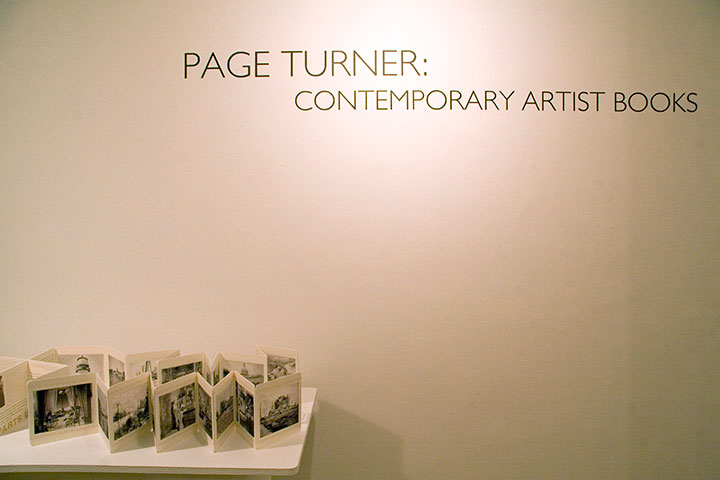
If you ever wanted to find out once and for all what the heck an artist book is, take a little field trip to Burien, WA. The group show Page Turner: Contemporary Artist Books is up this month at the Burien Arts Gallery, a tiny half-Cape house converted into a charming exhibition space.
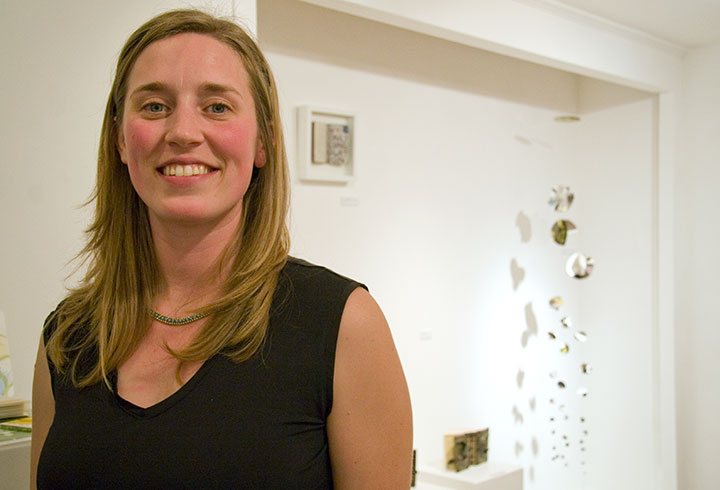
Kelda Martensen did a stand-up job of curating the show—and artist books aren’t easy to display, believe me. She’s represented a wide variety of work, from prints to traditional bindings to kinetic sculptures, featuring the work of artists nationwide, including Inge Bruggeman, Ken Botnick, Regin Ingloria, Jana Harper, Diana Guerrero-Macía, and many others.
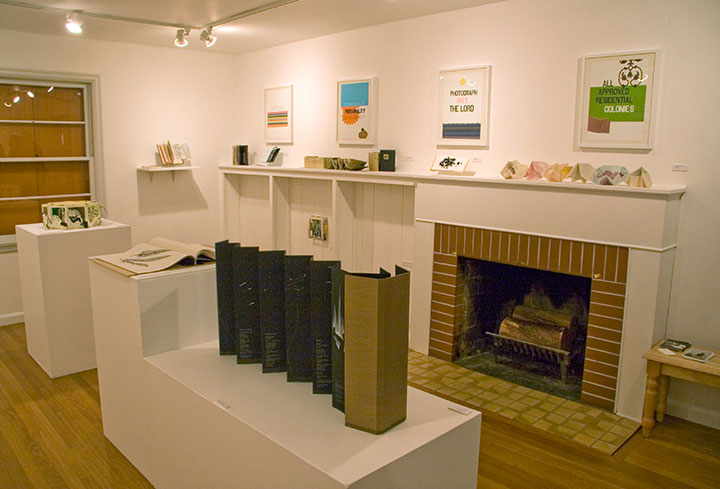
The gallery is open noon to four, Thursday through Sunday, and on Thursday, March 18, at 7 pm, Kelda will be giving a curator’s talk about the work in the show, sponsored by the Book Arts Guild. Free admission, always.

I’ve got a couple of pieces in the show, as well. Above is From Concentrate,
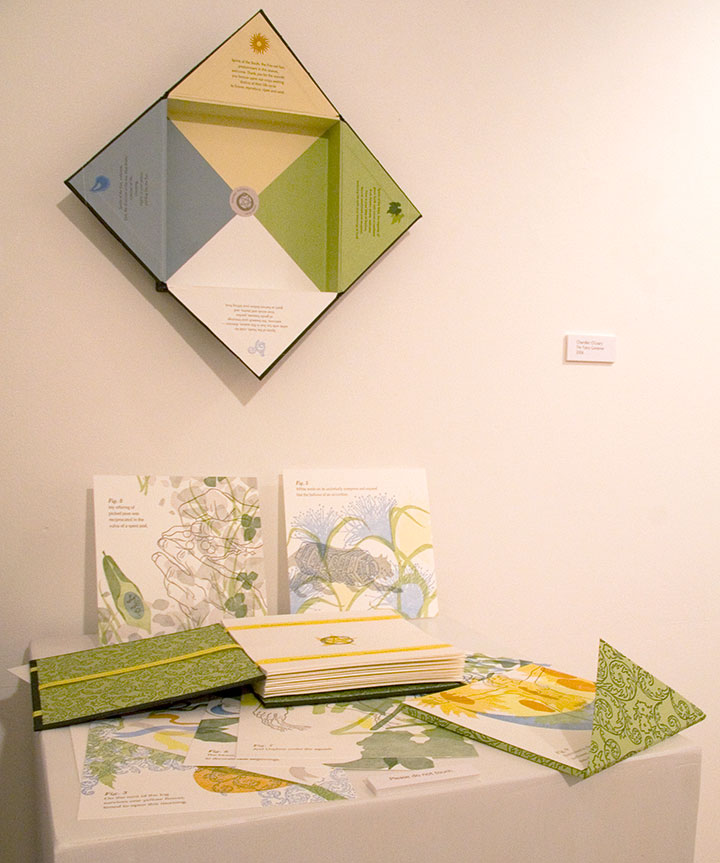
and this is The Faery Gardener.
Here’s the rub, though: the recession has hit all galleries where it hurts, but since the Burien Arts Gallery is run by the city, times have been especially tough there. This will be the last exhibit in the Cape Cod house; and possibly the last ever for Burien Arts, unless they can find public support, funding and a new space. So come check it out before they have to close their doors on March 19 (the website says they’re already closed, but you can still see the show).
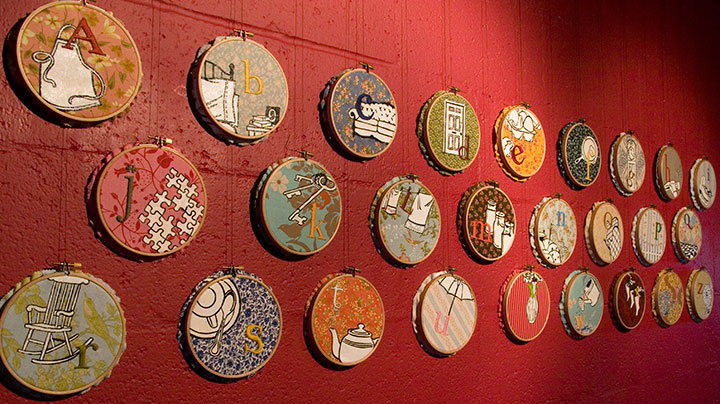
Speaking of artist books, if you missed Mnemonic Sampler at PLU, there’s another chance to catch the series in a new venue, closer to home: the Tempest Lounge, here in Tacoma.
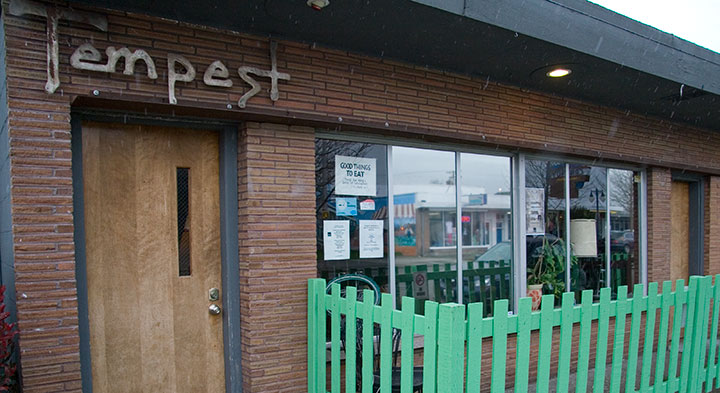
My friend Denise is the owner of the place, and when she asked if I was interested in showing there, I jumped at the chance. Although I love the clean beauty of a traditional gallery space, my favorite exhibition venues are the offbeat ones—restaurants, coffee shops, libraries, and now classy retro bars! I love these spaces because they bring art into real life, and invite folks to feast their eyes wherever they are. Most people (including myself, I must admit) are more likely to step into an eatery or a library than a gallery, and a coffee shop doesn’t have the same intimidating associations that some people have with galleries (that feeling of “If you’re not here to buy, you shouldn’t be here at all”). Plus, at the Tempest you can have a beer or cocktail while you look at the art. You can’t beat that.
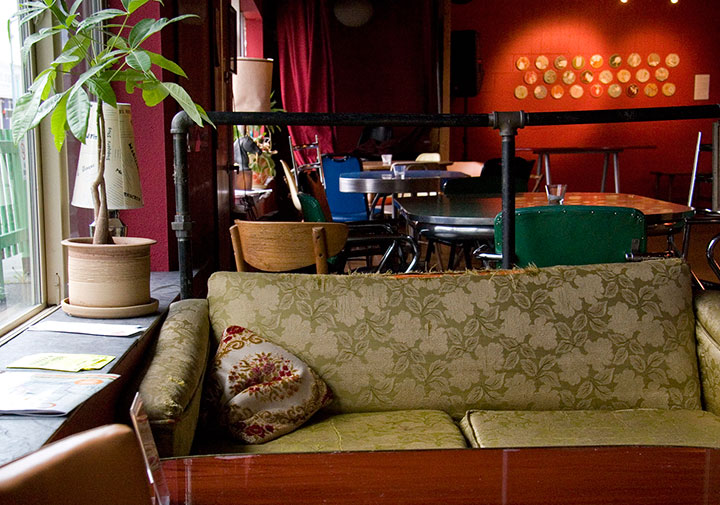
If beer isn’t your thing, you can also have a cuppa tea or joe, and the food is divine—Denise runs a classy joint here. So curl up on a retro couch for happy hour, come chat by the adorable green picket fence, or just stop in to take in that fabulous red wall. Mnemonic Sampler will be up through April 30.
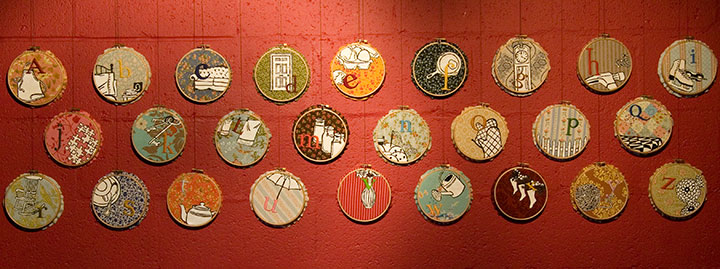
February 23rd, 2010
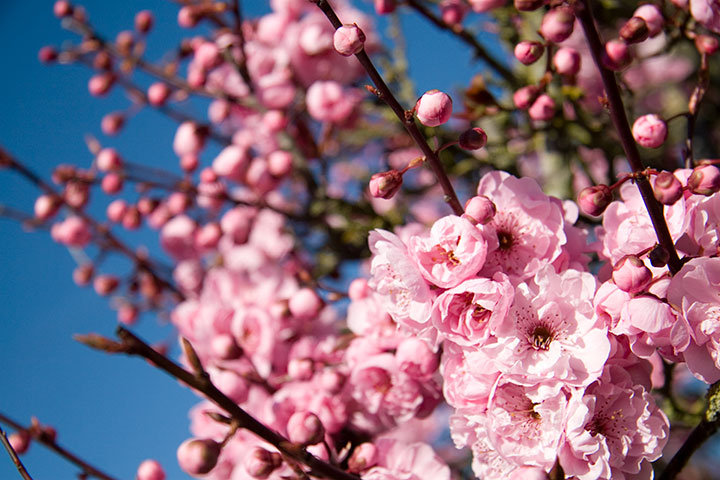
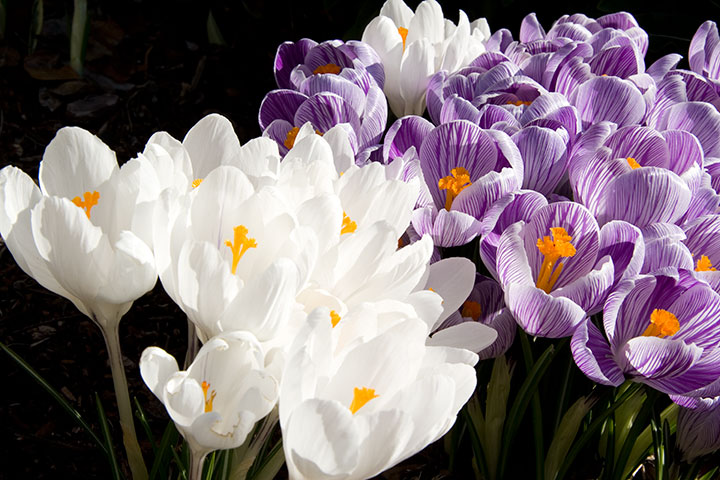
…it would be the unexpected blooming of an early spring.
February 13th, 2010
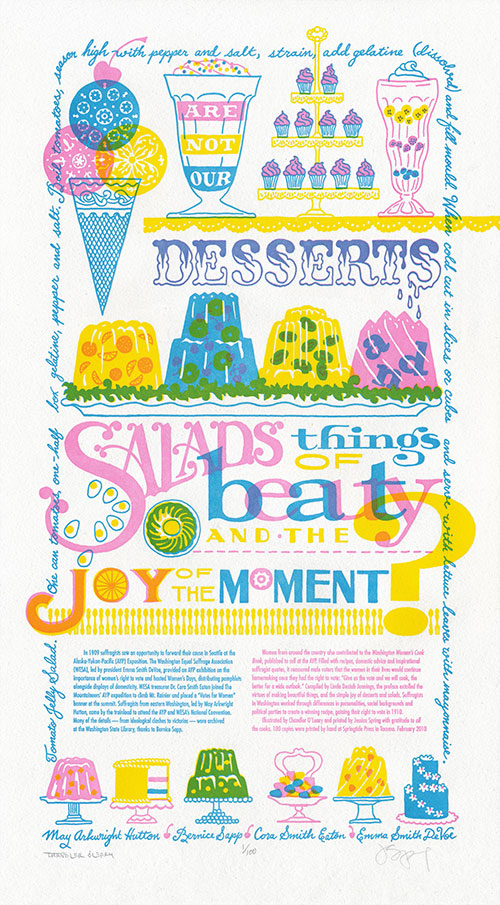

This year marks the 100th anniversary of women’s suffrage in Washington—a feat only made possible by the collaborative efforts of many dedicated people of every walk of life and political stripe. In this spirit, we present our seventh broadside in the Dead Feminists series, Just Desserts.
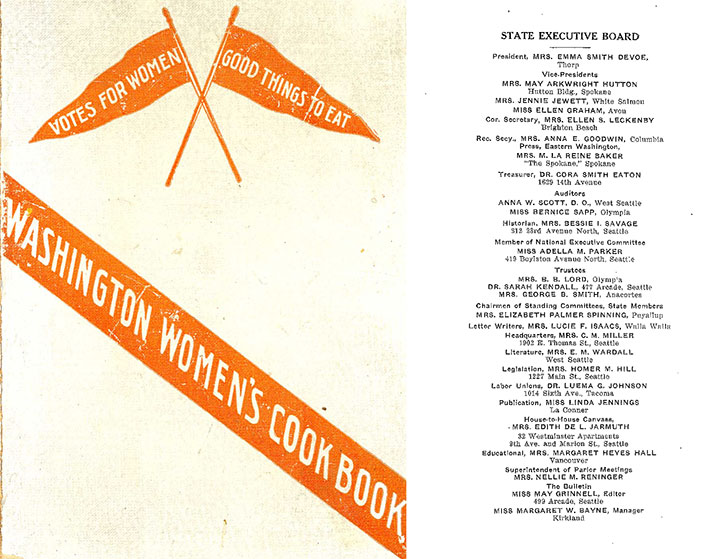
Through our research at the Washington State Library, we discovered that our state’s suffrage movement had many leaders, rather than one prominent figurehead. We also learned that there was so much head-butting, personality-clashing and partisan in-fighting going on within the organizations involved (Mesdames Hutton and DeVoe, I’m looking at you!) that it would be impossible to tell the whole story in one letterpress poster. So instead of quoting a single historical feminist, we cited a collaborative publication—the Washington Women’s Cook Book, published in 1908-1909 for the Alaska-Yukon-Pacific Exposition—and featured four women symbolic of the movement: May Arkwright Hutton, Bernice Sapp, Cora Smith Eaton, and Emma Smith DeVoe. The quote:
“Are not our desserts and salads things of beauty and the joy of the moment?”
The book was a clever piece of propaganda that operated on the principle that the way to a man’s heart—or vote—is through his stomach. All those jellied centerpieces and whimsical soufflés must have done the trick—the following year, women got the vote.
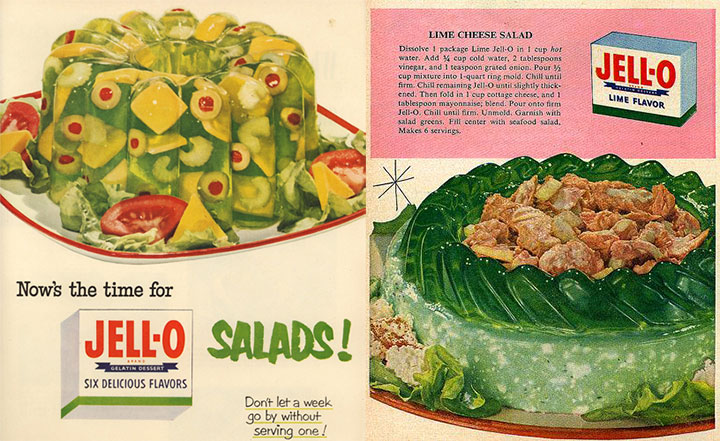
And for my part, the quote turned me into an almost-literal kid in a candy store; the design was just begging for elaborate confections and candy-coated typography. At first, though, I was turned off by the idea of having to draw salads (I wanted more ice cream!), until Jessica read off a litany of aspic salad and gelatin dessert recipes from the book. That’s when the light bulb turned on: Jell-o salad! The decade-plus I spent in the Midwest was about to serve me well.
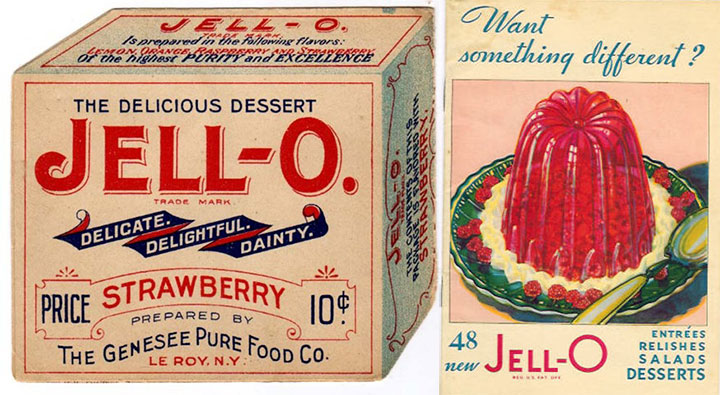
Turns out that Jell-o fit right into the turn-of-the-century theme: molded gelatin desserts were a Victorian favorite, and the name “Jell-o” was first coined in 1897 (and if you look carefully, the “J” from the original Jell-o box makes a cameo in the print). There seemed to be no end of antique recipes, advertisements and illustrations at my disposal.

I might be horrified by the idea of eating gelatin salads, but drawing them was the most fun I’ve had in a long, long time. Zooey and I each spent hours researching vintage Jell-o molds—probably more for the pure fascination than for the value of the reference material.
For the sweets portion of our little menu, I turned to an old favorite for inspiration: Andy Warhol.
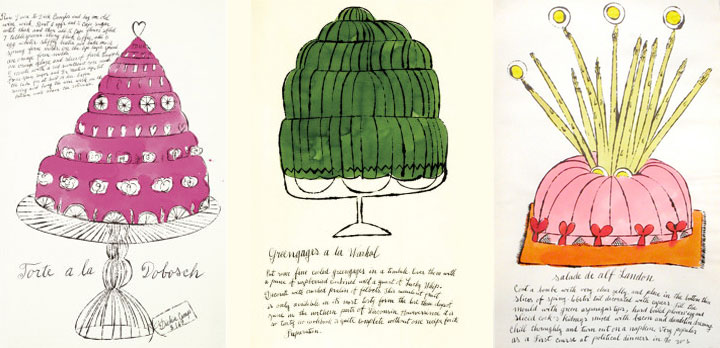
Forget what you know about Campbell’s soup cans or Elvis portraits; Andy got his start as an illustrator specializing in fashion and food. In 1959 he illustrated a spoof cookbook called Wild Raspberries (it’s been on my shelf since high school, and I finally found a direct use for it!), filled with ridiculous “gourmet” recipes for things like “A&P Surprise” (those of you in New England will get that one) and “Seared Roebuck.”
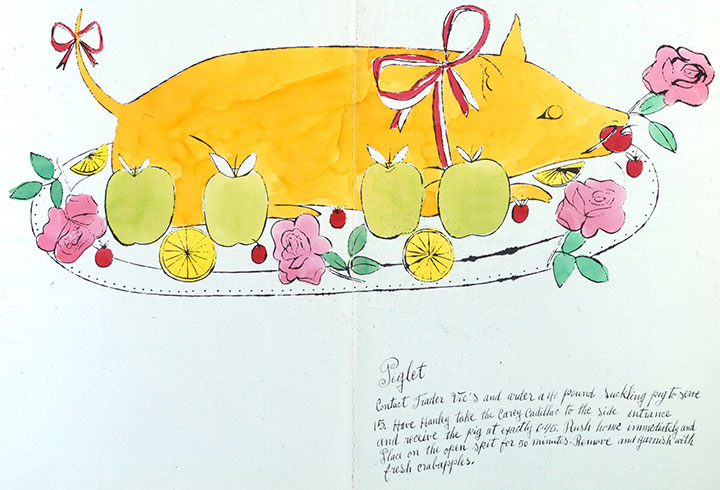
The illustrations are fantastic (and the polar opposite of my style), but the thing that really drew me in was the lettering. Andy had his mother, Julia Warhola, write all of the text of his early illustrations in her shaky, school-girl script. Mrs. Warhola spoke little to no English, and simply copied her son’s notes letter-for-letter, so the text in Wild Raspberries has charming errors and misspellings throughout.

I loved the down-to-earth quality of Mrs. Warhola’s cursive, so I wrote a recipe from the Washington Women’s Cook Book along the border of the broadside in a similar hand (though to warn you, it’s a recipe I wouldn’t recommend trying!).
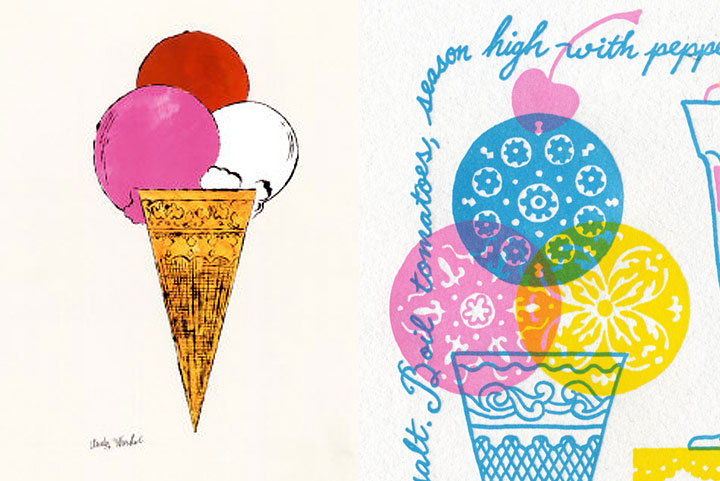
And of course, I couldn’t do without a little ice cream homage.
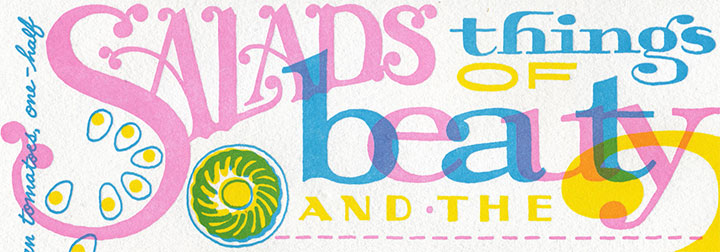
Like The Curie Cure, this piece is printed in three colors—although the three we chose let us create many more. Our color scheme allowed us to print in a similar fashion to commercial printing, where a minimum of colors (CMYK—cyan, magenta, yellow, black) are layered to create a full-color image. Our layering of translucent pink, blue and yellow ink allowed us to create a full rainbow and a convincing depiction of foreign objects floating in jelly.
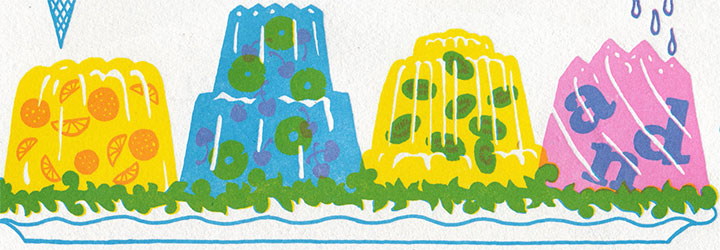
Heaps of thanks to everyone who came to our talk at the State Library the other night, despite lousy weather and rush-hour traffic—we had a tremendous turnout, and a huge show of support for our state’s oldest cultural institution.
One more thing: three cheers for the incredible staff at the Washington State Library (many of whom are among those whose jobs have been cut and will end very soon) who made our talk and this very piece possible. Because we couldn’t have done it without them, we have donated a portion of our proceeds to support the State Library’s collections.
After all, it’s about preserving (in jelly?) that joy of the moment for everyone to share, right?
• • • • • • • • • • • • • • • • • • • • • • • • • • • • • • • • • • • • • • • • • • • • • • • • • • • • • • • • • • • •
Just Desserts: No. 7 in the Dead Feminists series
Edition size: 100
Poster size: 10 x 18 inches
Printed on an antique Vandercook Universal One press, each piece is printed on archival, 100% rag, recycled paper, and signed by both artists.
Colophon reads:
In 1909 suffragists saw an opportunity to forward their cause in Seattle at the Alaska-Yukon-Pacific (AYP) Exposition. The Washington Equal Suffrage Association (WESA), led by president Emma Smith DeVoe, provided an AYP exhibition on the importance of women’s right to vote and hosted Women’s Days, distributing pamphlets alongside displays of domesticity. WESA treasurer Dr. Cora Smith Eaton, joined The Mountaineers’ AYP expedition to climb Mt. Rainier and placed a “Votes for Women” banner at the summit. Suffragists from eastern Washington, led by May Arkwright Hutton, came by the trainload to attend the AYP and WESA’s National Convention. Many of the details—from ideological clashes to victories—were archived at the Washington State Library, thanks to Bernice Sapp.
Women from around the country also contributed to the Washington Women’s Cook Book, published to sell at the AYP. Filled with recipes, domestic advice and inspirational suffragist quotes, it reassured male voters that the women in their lives would continue homemaking once they had the right to vote: “Give us the vote and we will cook, the better for a wide outlook.” Compiled by Linda Deziah Jennings, the preface extolled the virtues of making beautiful things, and the simple joy of desserts and salads. Suffragists in Washington worked through differences in personalities, social backgrounds and political parties to create a winning recipe, gaining their right to vote in 1910.
Illustrated by Chandler O’Leary and printed by Jessica Spring with gratitude to allthe cooks. 100 copies were printed by hand at Springtide Press in Tacoma. February 2010
UPDATE: poster is sold out. Reproduction postcards available in the Dead Feminists shop!

February 10th, 2010
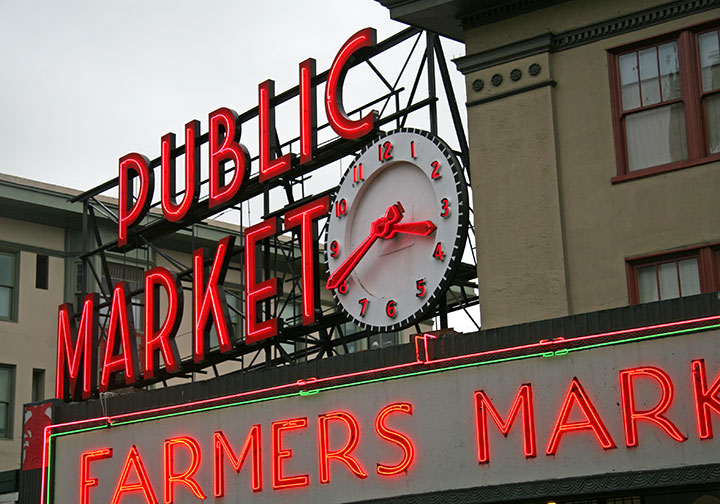
The past couple of weeks have been an absolute whirlwind, and when I look in the mirror I see a walking, talking to-do list. The notes-to-self strewn all over the studio (among half-finished boxes, reference materials, pencil layouts, proof prints, watercolor pans, etc.) aren’t enough, so now I’ve taken to muttering little reminders under my breath—call this client, mail this order, drop off this pile of prints, invoice this subscriber, edit this illustration, proof these plates, cut this book cloth, list these cards, upload these photos, etc.
I needed a break. So today I bolted to Seattle to clear my head.

One of my favorite hobbies is wandering around the Market alone, especially on winter weekdays when it’s pretty much empty. Losing myself among the fruit stalls and neon is as therapeutic as meditation.
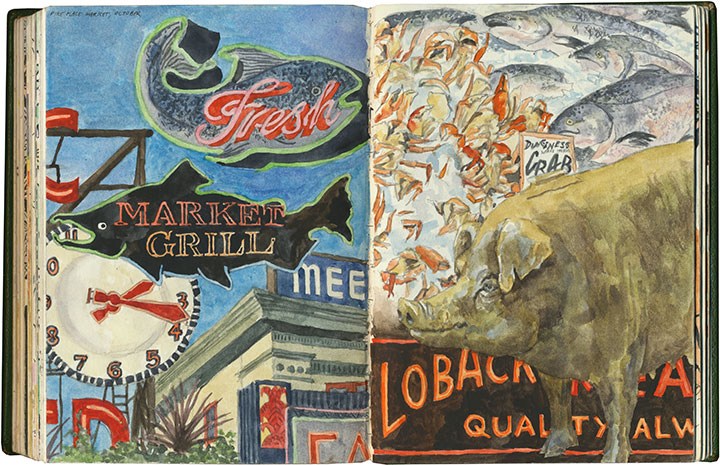
I wasn’t in the drawing mood this time, but the Market is also on my short list of all-time favorite sketching haunts. This is one from a year ago or so, on a completely packed, sunny Saturday, when I flattened myself against poles and ducked down onto the curb to draw without being trampled by tourists.
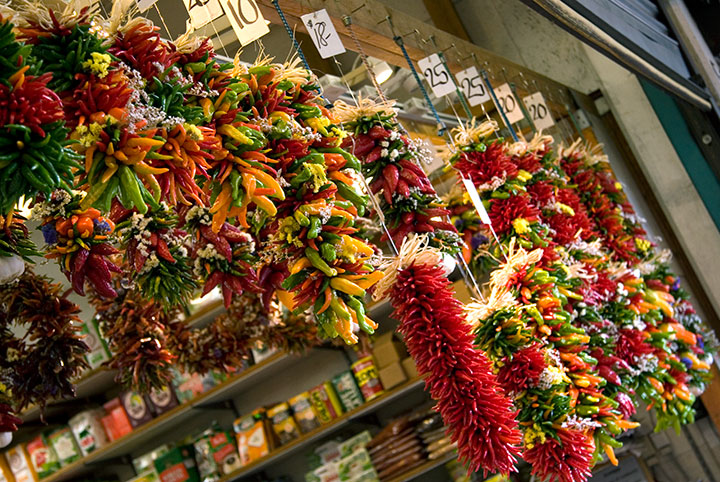
I love it for the people-watching when it’s crowded, but there’s something special about having the place to myself. There is a downside, however (besides being heckled by bored fishmongers): it’s awfully hard not to splurge on sampling from the unbelievable smorgasbord of fresh goodies.
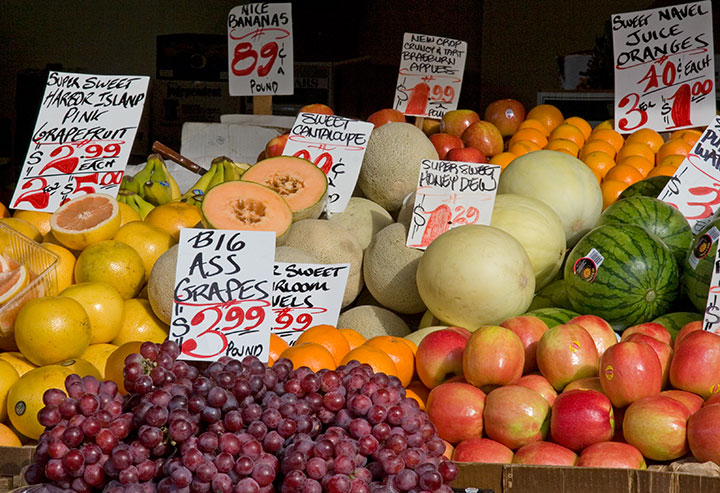
Now how could I say no to that?
January 30th, 2010
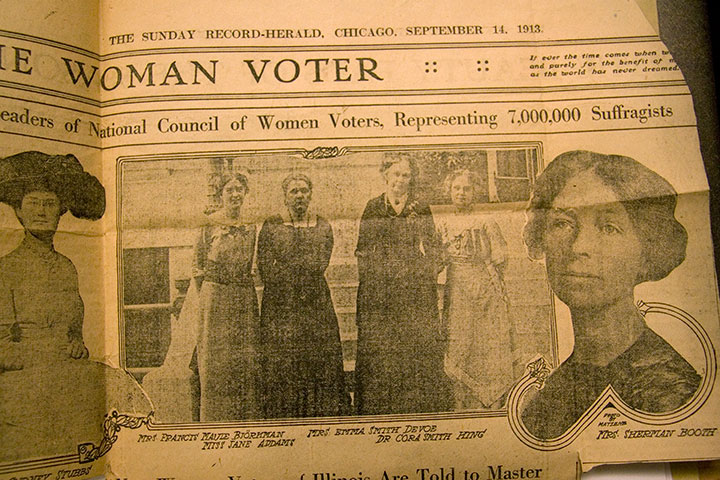
It’s just about that time again: Jessica and I are working hard on the next Dead Feminist broadside. She’s poring through texts and historical facts, and I’m pencilling as fast as my tendonitis will let me. This time we’ll be unveiling the new piece at the Washington State Library near Olympia; the staff invited us to give a lecture about the series next month.
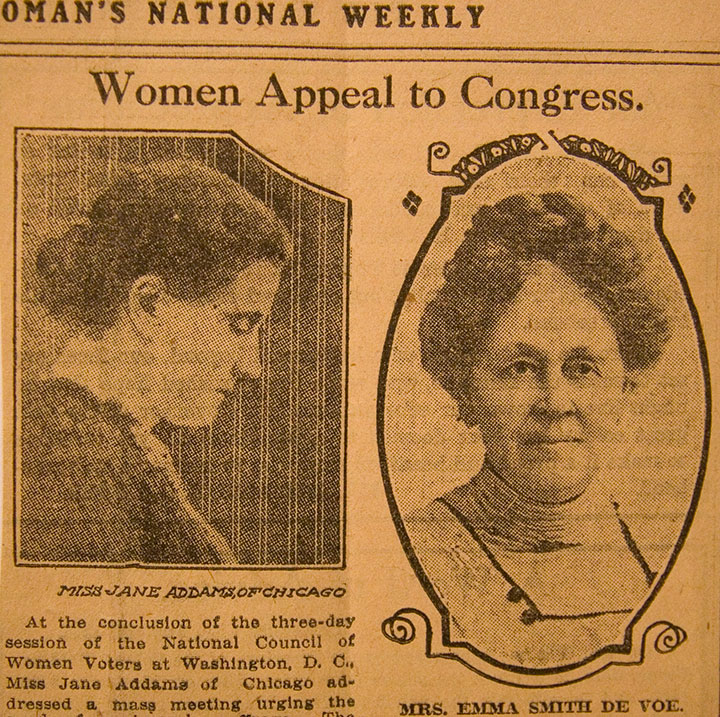
The library boasts the entire collection of letters and personal papers of Emma Smith DeVoe (pictured above, right), women’s rights activist and leader of the Washington suffragist movement. And since this year marks the 100th anniversary of women’s suffrage in Washington, we figured Emma would be a perfect fit for the new piece.
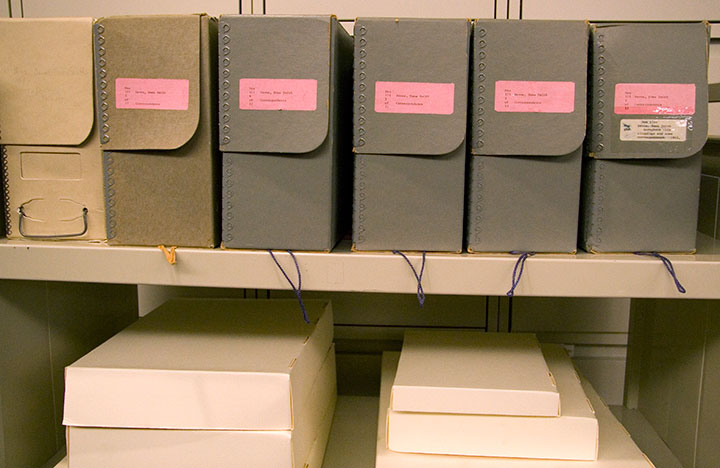
So a couple of weeks ago, Jessica, Zooey (R.I.P., J.D. Salinger) and I took a field trip to visit the archives and conduct a little research. When we arrived, we realized what they meant by “collection:” twelve enormous boxes packed full of letters, clippings and souvenirs. A “little” research obviously wasn’t going to happen.
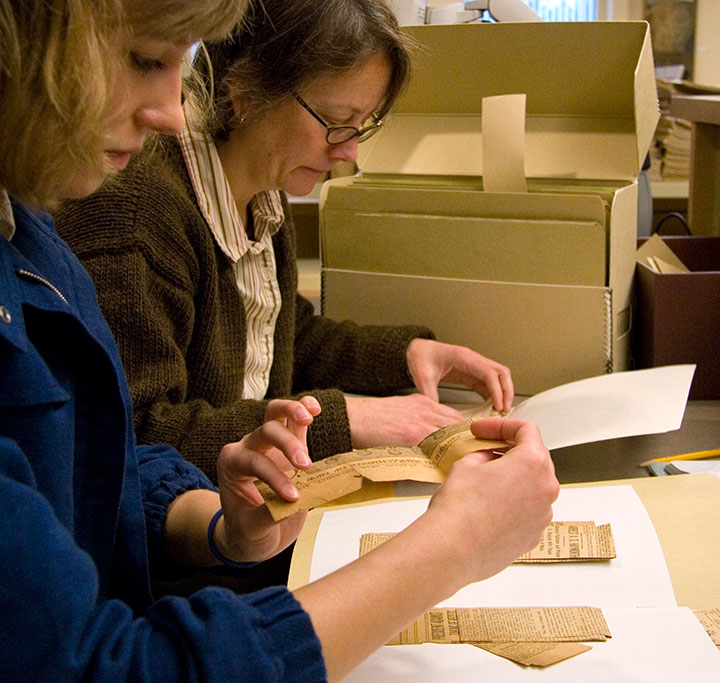
Luckily, the incredibly knowledgeable and helpful library staff (thank you, Sean!) let us take as much time and as many photos as we needed. So we cozied up to a work station and dived in, one box at a time. Together we went through literally thousands of pieces of paper.
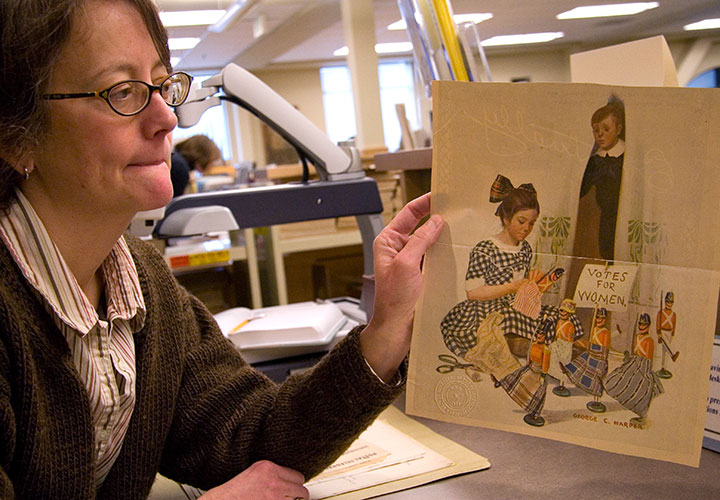
What we found was a fascinating collection of souvenirs, business cards, newspaper clippings,

leaflets and other propaganda,
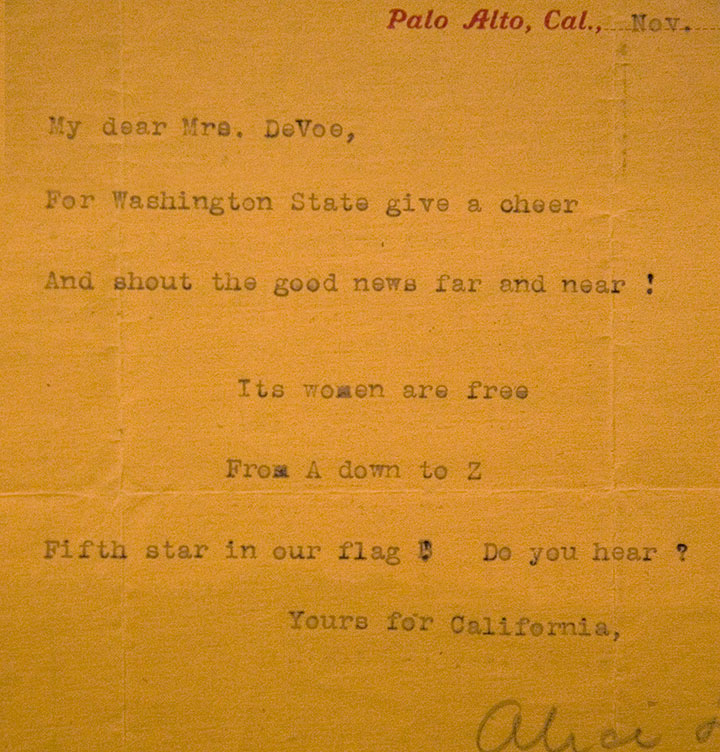
fan letters (Emma had an impressive array of admirers),
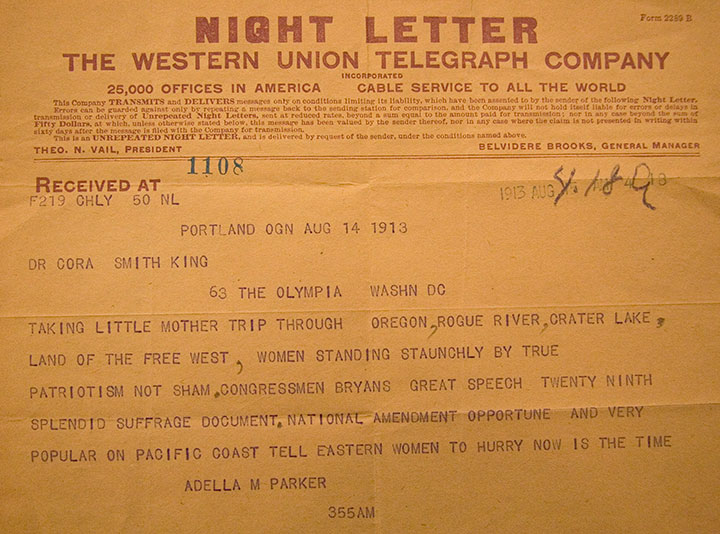
telegrams, notes from sitting U.S. senators and presidential aides, and reams and reams of correspondance between the members of the Washington suffragist movement.
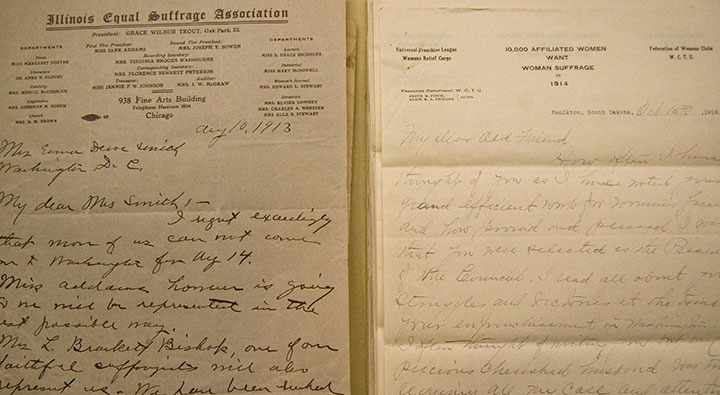
The trouble was, most of these documents were utterly mundane—letter after letter simply acknowledged receipt of previous correspondance, or gave detailed instructions for planning events and delegating tasks. Worst of all, Emma rarely made carbon copies of her half of the correspondance, so there was very little in her own voice.
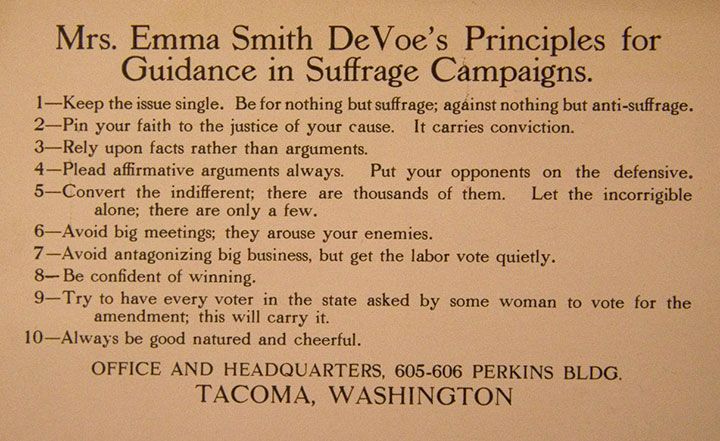
We spent nearly four hours poring over every folder and box, and the only potential Emma quotes we found were mined from this instructional card. Still, it didn’t feel like we had found our inspiration—just a few weeks from our talk, we had no quote and no social topic for the piece.
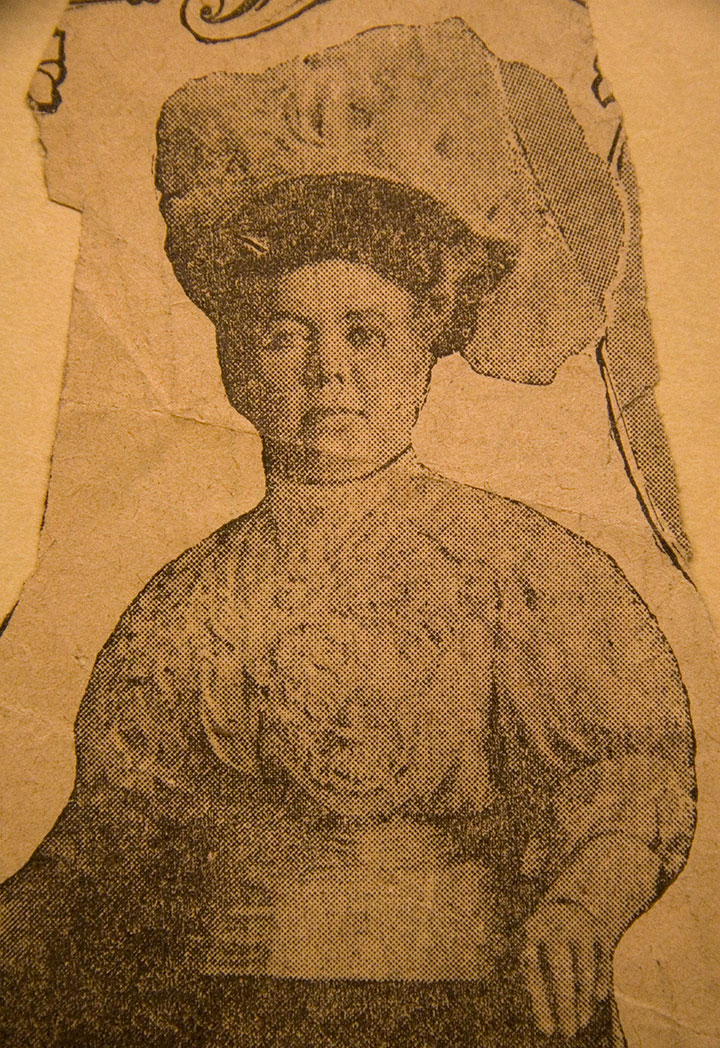
What we did have, however, was a much clearer picture of the women behind the fight for suffrage in our state (that’s May Arkwright Hutton above; she and Emma didn’t exactly get along), right down to addresses of homes and buildings still standing in Tacoma (the headquarters of the movement).
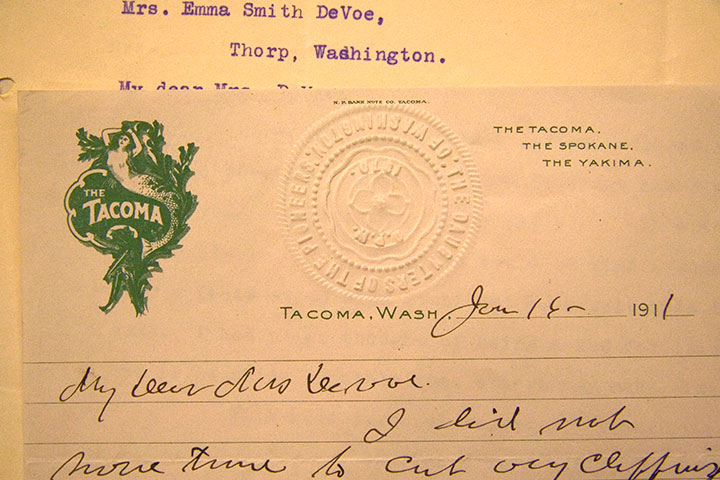
From the documents themselves to the individual script hands of each letter writer, we had an incredible window into political life from a hundred years ago.
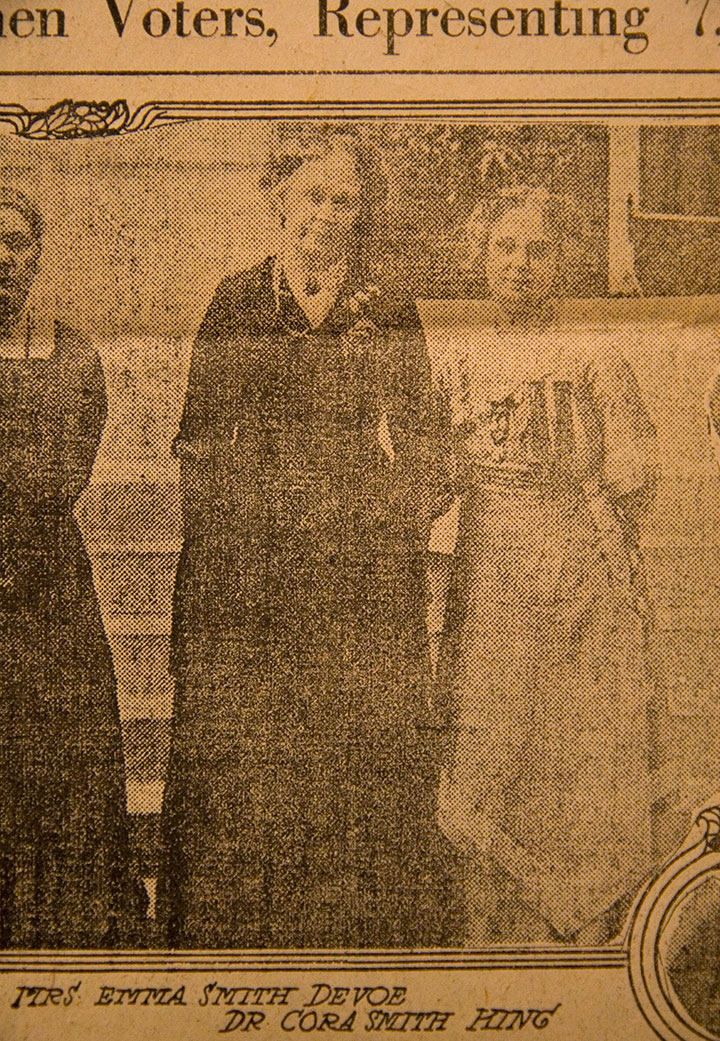
And we found a good lead. Just as interesting as Emma (and more forthcoming with their own voices) were Cora Smith Eaton King, M.D. (pictured above, right)—correspondent, fellow leader of the movement, and one of the first women to scale Mt. Rainier!—and Bernice Sapp—friend, activist, and the one who compiled this collection of documents and donated it to the library.
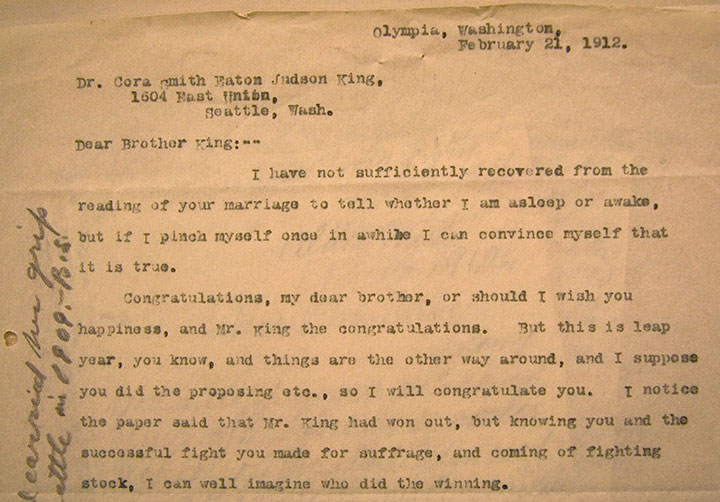
Bernice’s letters were full of quirky character and wit. We loved how she called Emma “the General,” and referred to herself and other suffragists by male titles: “Brother King,” “Mr. Hutton,” or simply “him.”
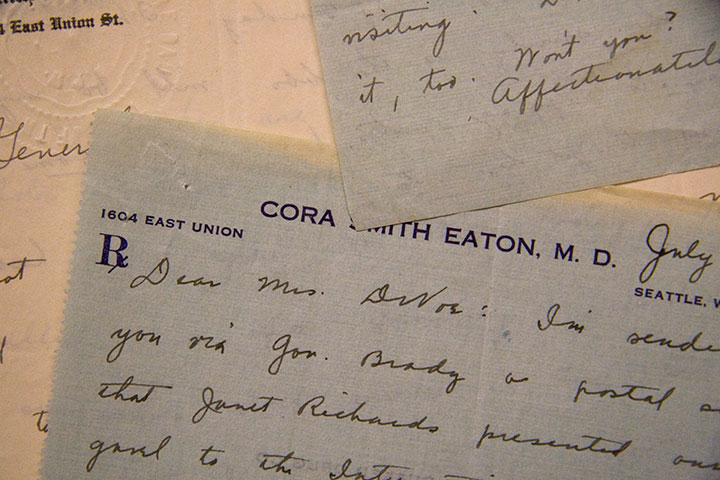
Cora, on the other hand, was a real firecracker. Her letters (often scribbled on scraps of paper, even her own prescription pad!) revealed an eloquent intelligence and a sizzling sense of humor. We fell head-over-heels for Cora, and began to doubt that Emma was the right voice for the broadside—still, though, we had no quote from any of these women.
A few days later, Jessica hit up the astounding Northwest Room at the Tacoma Public Library, and hit the jackpot. She discovered a document that linked all of these women together, which decided us on a slightly different approach to quoting historical feminists. That’s all I’ll say for now, except that the new broadside may or may not depict a certain quivering, questionable “food” substance:

If you want to be one of the first to see what the heck I’m talking about, I invite you to come check out our talk at the Washington State Library. Here are the details:
Pressing Matters: an evening with Chandler O’Leary and Jessica Spring
Wednesday, February 10, 2010
6:30 p.m. (doors open at 6:00), free!
Washington State Library
6880 Capitol Boulevard, Tumwater, WA
Libraries and archives face a tough reality in the current economy—especially here in Washington, where a regressive tax system has left the State Library with a 30% staff reduction and major cuts to its operating and acquisitions budgets. The 2003 earthquake damaged their building on the historic capital campus in Olympia, and forced them to relocate “temporarily” to a suburban office park a few miles south in Tumwater. Even when the economy recovers, it is unlikely the library’s funding will return to the levels it enjoyed in more prosperous eras, so the move to Tumwater is looking increasingly permanent. Despite these setbacks, the State Library continues to acquire new items (including our artwork!) for the collection and provide an essential service in preserving our state’s history. So please come and show your support for the library—a good turnout will help them provide more public events in the future, and might just go a long way toward saving them from another visit to the chopping block.
January 23rd, 2010
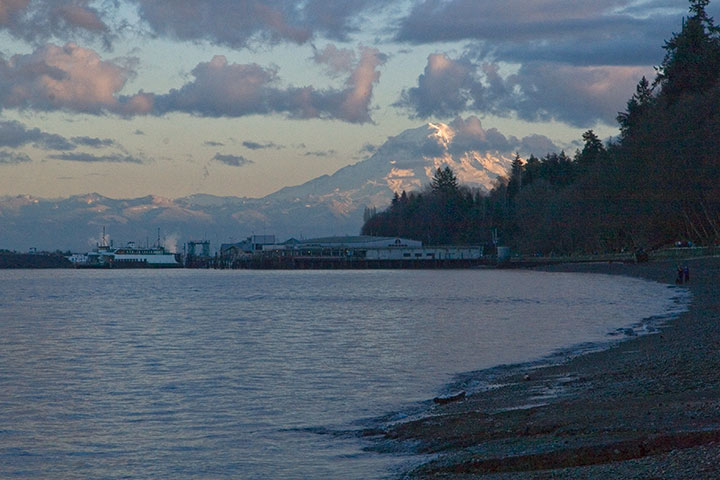
After weeks and weeks of typical winter rain, the Tailor and I took advantage of a rare sunny afternoon and headed to Point Defiance for a stroll on the beach. We quickly discovered that nature had a few surprises for us today—beyond the perpetual shock of Mount Rainier appearing out of nowhere, that is.
The tide was way, way out today; not quite a spring tide, but almost. It was a steep descent down to the water, the crazy slope creating the optical illusion of standing below sea level. At the water’s edge we met a couple of unlucky creatures left high and dry by the tide:
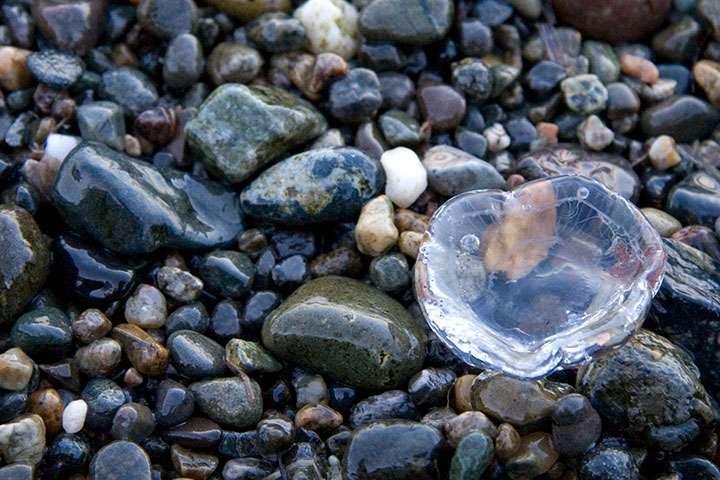
first a half dollar-sized jellyfish that strayed too far into the shallows…

and then a hapless sea star who apparently made a bad choice in real estate (talk about being upside-down on your mortgage).
But the surprise of stranded jelly- and starfish was nothing to the shock we received on our way back, just a few blocks from home:
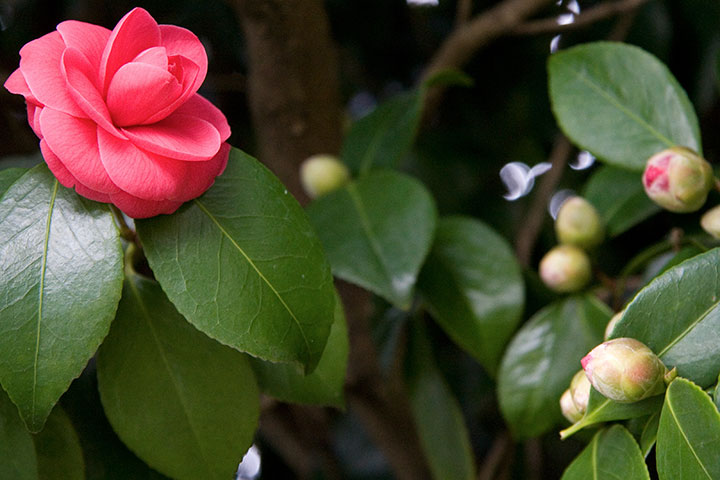
Camellias. Blooming in January. Now, I’m quite confident that I can adapt to the short, snow-less winters in these here parts—but flowers in January? I don’t think I’ll ever be able to wrap my brain around that.
(Not that I’m complaining, mind you.)
January 17th, 2010

Thing number 386 that they don’t teach you in art school: how to navigate local business excise tax laws.
My wonderful and brilliant accountant takes care of the heavy lifting of my federal business taxes, but since the deadline to pay the Washington piper falls before the federal paperwork even arrives in the mail, I file my state taxes on my own. To be perfectly honest, I take a kind of perverse pleasure in bean-counting—there’s something satisfying about the annual financial housekeeping rituals of compiling and tallying. But now that I own a business in a state that relies solely on sales tax revenue, business excise taxes and weird, archaic, late 19th-century property-assessment laws that tax my homemade bookshelves and vintage filing cabinets (I kid you not), the annual tax ritual has turned into an entire weekend curled up with my calculator.
Since I’m obviously a tax-happy liberal gal who loves her some socialist blueberries (not to mention public libraries and paved roads), I’m perfectly glad to fork over the revenue—I’d just love it if they’d just levy an income tax instead, and spare me (and all those poor state employees) the paperwork nightmare!
Political grumblings aside, I’m just chalking this up to All Those Really Important Things You Have to Learn on Your Own When You Start a Business. I’ve got some fun stuff to share with you, but I’ve gotta get this stuff done first. In the meantime, playing in my head over and over again is that little diddy Bobby McFerrin sang on Square One: “Anything you wanna be, you’ve got to know math.”
So true, Bobby. So true.
January 10th, 2010

I find I’m spending more time at the drafting table these days, and far fewer hours chained to the computer. This month I am blessed with an assistant—a brilliant young woman who is helping me with my administrative and production work, in exchange for school credit, a little professional experience and the chance to beef up her design software skills.
We’re lucky to have here in T-town an arts-magnet public high school, and part of the curriculum for juniors and seniors is an internship opportunity during the winter term. I was completely ignorant of this until I received Zooey’s email last fall, asking if I would be willing to take her on. I almost turned her down, simply because I couldn’t imagine I’d have enough to keep her busy and interested for three 40-hour weeks.
But then it occurred to me that I might be able give her an accurate idea of what it’s actually like to make one’s living as a full-time artist—which largely consists of being one’s own secretary, account manager, bean-counter, marketing department, production assistant and gopher, as well as coming up with all the creative ideas. That’s something I wish I had known as a student, and yet was certainly never taught in art school.
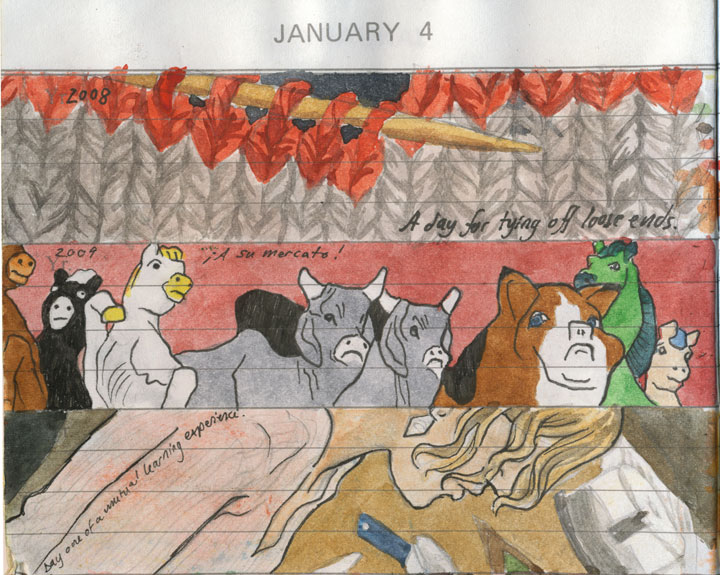
As it turns out, there’s plenty of work for both of us, and it’s been a mutual learning experience. Zooey (not her real name, in keeping with my little privacy policy) is picking up design skills they aren’t teaching at the high school level, attending client meetings and press checks, learning the ins and outs of seeing a project from concept to completion, and contributing her own ideas to creative discussions and brainstorming sessions. And I’m able to spend more time actually creating artwork, rather than endlessly playing catch-up with back-burner projects that should have been done months ago (although I crossed my heart and made her a solemn vow that I would get my own damn coffee).
The best part is having good company during the day. Running a one-woman shop is pretty solitary work, and learning that Zooey is not only a talented artist but also a mutual audiophile and movie geek made her an instant kindred spirit. (It was funny to discover that we both have a habit of singing along with the background music, but often choose different vocal parts to follow: harmony is so much more fun than a solo.) So these days I’m churning out new work and ideas faster than ever, while Zooey keeps a hand on the metaphorical wheel—and all the while the studio is filled with music and laughter.
I’m a control freak by nature, so I’m pleasantly surprised to find myself capable of letting go of the reins a bit. And I was even more surprised to learn that Zooey is the only student working with an individual artist this year (everyone else is working with firms or large companies). Here’s hoping that other artists and freelancers open their doors and minds to future students—there’s so much to learn, on both sides.

December 22nd, 2009
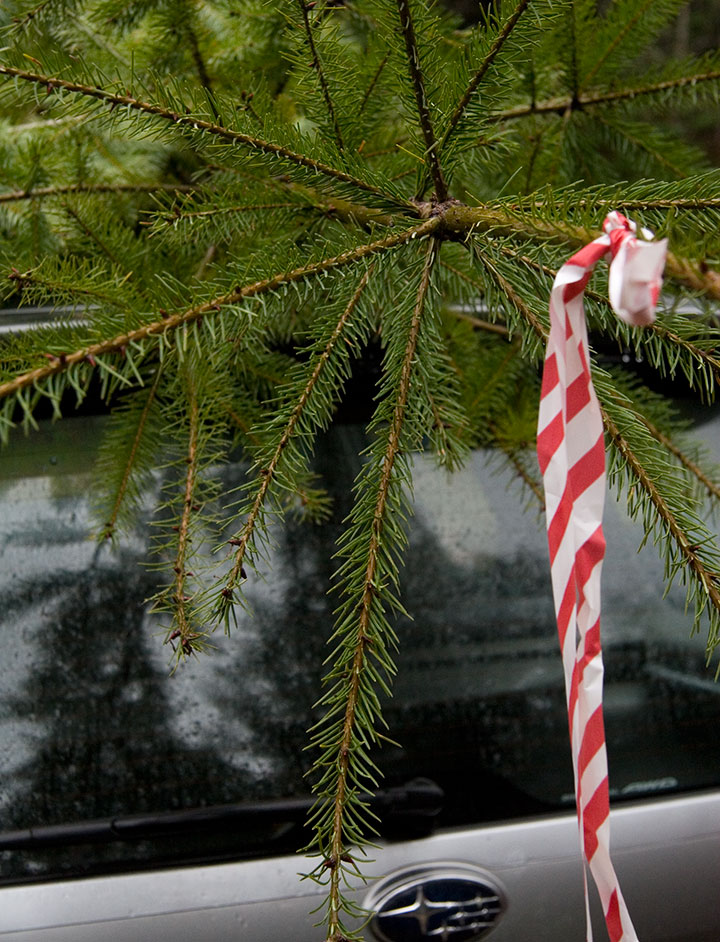
If you’ve been reading this blog for awhile, or you’ve met me or the Tailor, you already know about our penchant for storing food and taking seasonal eating to hardcore extremes. But our nuttiness about walking the talk extends far beyond the pantry. Another aspect of our attempts to live as sustainably as we can is our rejection of synthetic materials. Now, we’ll never live entirely free from petroleum products—we drive a car. We own a refrigerator, a stereo and a plethora of records, tapes, CDs and DVDs. I use a computer, a scanner, a digital camera, and a host of accompanying accessories. I’m not about to buy underwear with a button waist. I gleefully print with photopolymer plates. And we just can’t let go of our small, sentimental collection of deliciously hideous, ancient Tupperware. But all things considered, you’d be hard-pressed to find much plastic in our house. Whenever possible we buy clothing, tools, containers, furniture, and everything else made purely from natural materials: wood, metal, glass, cotton, linen, wool, silk, bamboo, cork, bone, shell. Much of the time, nowadays, that means we have to look for vintage versions of whatever we’re shopping for, but you’d be surprised at what’s available—as long as one is willing to search for it. I know how extreme this position is—and believe me, it’s not something that can be done overnight. This is a process years in the making, and just the fact that we’re still working at it (and probably always will) shows that it’s not for everyone, and certainly not the only solution out there. But the biggest benefit of it all is how long-lasting our belongings are—and when things break, they can usually be mended, rather than thrown away and replaced.
The biggest downside, however, is that by choosing this path we also choose to abstain from some creature comforts and cultural elements that are dated from after the advent of plastic. Most of the time I don’t miss it—or even notice anything lacking. But right now, during the holiday season, I have a fierce craving for twinkle lights that I just have to resist (if anyone can find me twinkle lights made entirely of glass bulbs, metal wire and cloth cord, I’ll be all over it).
Even with our solemn vows to thwart plastic, our search for a Christmas tree left us in some doubt (I grew up with an artificial tree, and have only had one Christmas tree of my own—a real one, three years ago). Is it better to buy a fake tree once or intentionally kill fifty-odd living evergreens in one’s lifetime? Which is worse—fossil fuels or deforestation? How about burning fossil fuels on our way to deforest a section of land?! (The irony of the freshly-killed tree tied to a hippie Subaru in the above photo isn’t lost on me.) And can one family really do so much damage just by celebrating the holidays, or should we just stop worrying so much?
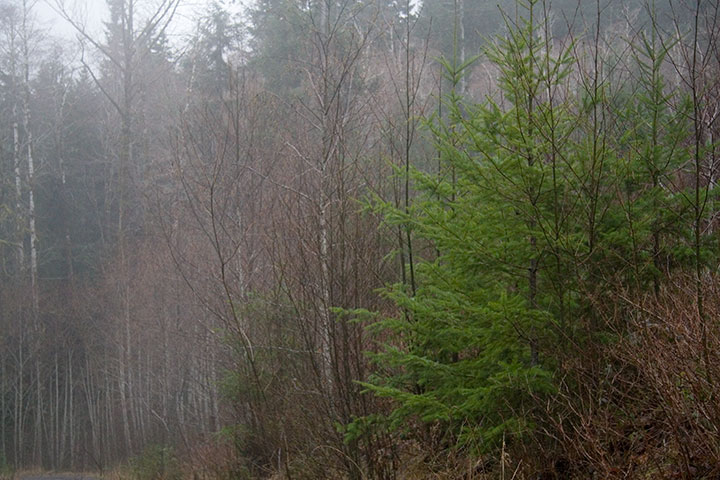
In the end, we followed the same instincts we rely on for our choice to remain omnivores: we decided on a real tree (after all, we do live in a place with abundant trees that shoot up fast, thanks to our rainy climate), as long as it could be culled responsibly. So we called up some friends who own land near Olympia, and as luck would have it, there were some young Douglas-firs on their property that were scheduled to be removed in the spring.
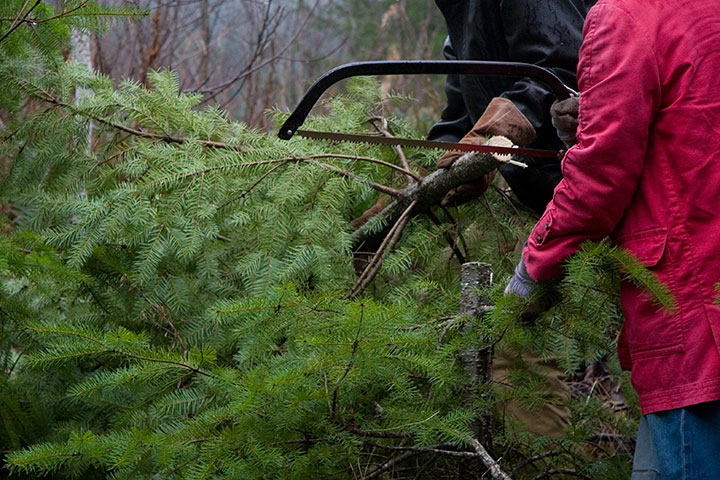
A little elbow grease later, we had our Christmas tree.
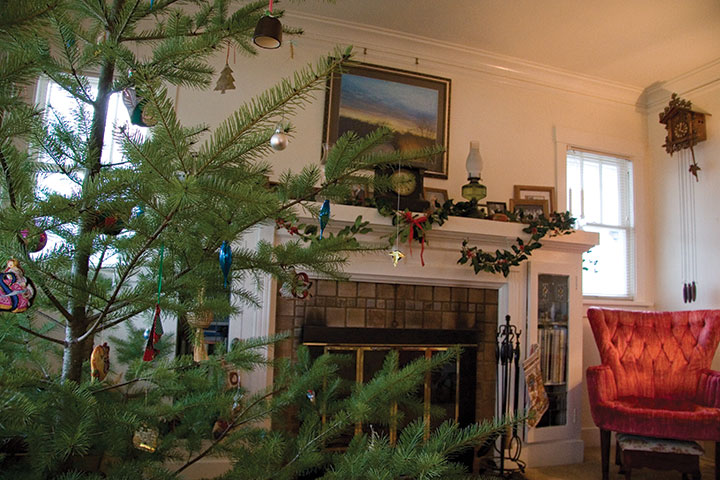
It doesn’t have the textbook perfection of a farmed tree, but it looks lovely in the living room, bedecked in handmade and vintage ornaments (I think there are exactly four plastic items contained therein). And as we decorated it on the solstice, I privately gave thanks to the land for contributing to our holiday.
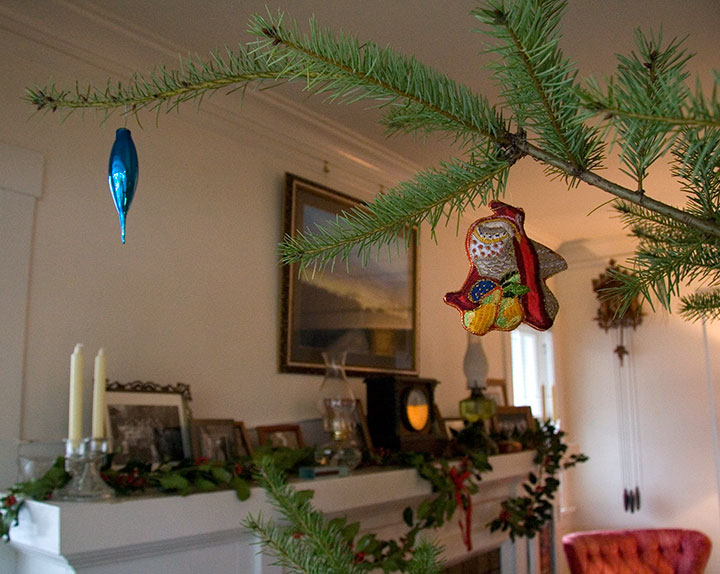
Now that we live in a house with a fireplace, we can finally hang the stockings by the chimney with care. And with a fireplace comes a mantel just begging to be decorated.
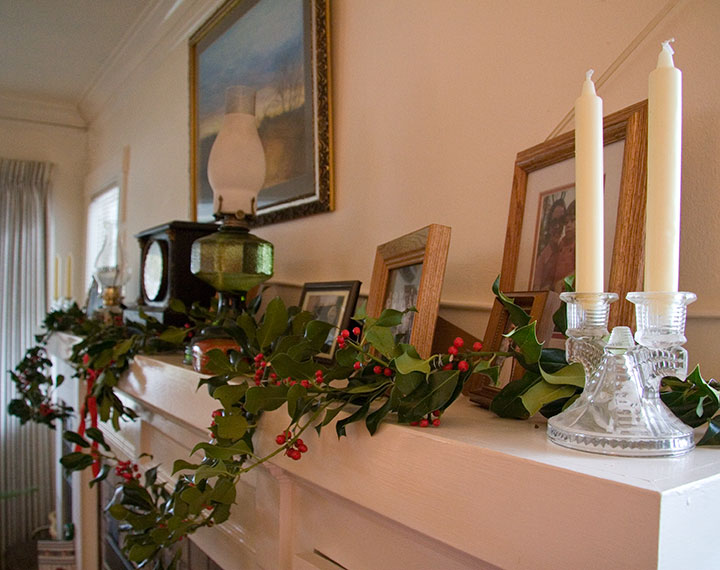
So another friend invited us to clip some holly branches (holly is a beautiful but noxious weed around here, so pruning is always welcome) from his back yard, and with the help of a little steel wire I whipped up a Christmas garland.
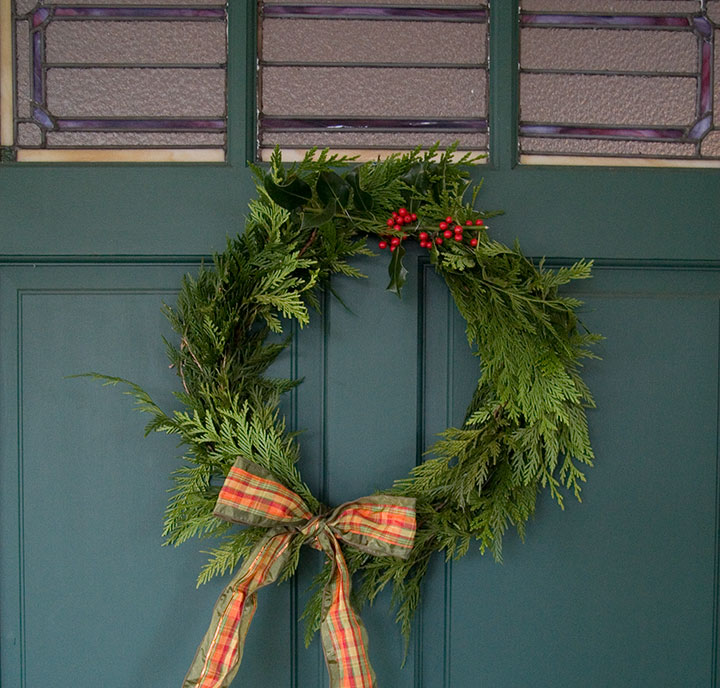
We used a bit of leftover holly and some cedar prunings for a wreath, and suddenly it was Christmas at our house. So maybe I don’t have my beloved twinkle lights, but somehow it feels better this way. We had a big holiday potluck last night, with thirty or so people crammed into our living and dining rooms, bellowing carol harmonies and exploding crackers and cheering when the Tailor poured blue-flaming brandy on the plum pudding. And nearly every one of them said it felt like their grandmother’s house, or their childhood traditions, or what they imagined of Christmases past. So maybe I don’t so much need that string of lights.
Still, since the moment we decided on a real tree I’ve been reminded of my favorite Robert Frost poem—which might make me all the more conscious of our choice, but also more appreciative of the holiday in general. After all, a Christmas tree is something the city “could not do without and keep its Christmas.”
Christmas Trees
(A Christmas Circular Letter)
The city had withdrawn into itself
And left at last the country to the country;
When between whirls of snow not come to lie
And whirls of foliage not yet laid, there drove
A stranger to our yard, who looked the city,
Yet did in country fashion in that there
He sat and waited till he drew us out
A-buttoning coats to ask him who he was.
He proved to be the city come again
To look for something it had left behind
And could not do without and keep its Christmas.
He asked if I would sell my Christmas trees;
My woods—the young fir balsams like a place
Where houses all are churches and have spires.
I hadn’t thought of them as Christmas Trees.
I doubt if I was tempted for a moment
To sell them off their feet to go in cars
And leave the slope behind the house all bare,
Where the sun shines now no warmer than the moon.
I’d hate to have them know it if I was.
Yet more I’d hate to hold my trees except
As others hold theirs or refuse for them,
Beyond the time of profitable growth,
The trial by market everything must come to.
I dallied so much with the thought of selling.
Then whether from mistaken courtesy
And fear of seeming short of speech, or whether
From hope of hearing good of what was mine,
I said, “There aren’t enough to be worth while.”
“I could soon tell how many they would cut,
You let me look them over.”
“You could look.
But don’t expect I’m going to let you have them.”
Pasture they spring in, some in clumps too close
That lop each other of boughs, but not a few
Quite solitary and having equal boughs
All round and round. The latter he nodded “Yes” to,
Or paused to say beneath some lovelier one,
With a buyer’s moderation, “That would do.”
I thought so too, but wasn’t there to say so.
We climbed the pasture on the south, crossed over,
And came down on the north.
He said, “A thousand.”
“A thousand Christmas trees!—at what apiece?”
He felt some need of softening that to me:
“A thousand trees would come to thirty dollars.”
Then I was certain I had never meant
To let him have them. Never show surprise!
But thirty dollars seemed so small beside
The extent of pasture I should strip, three cents
(For that was all they figured out apiece),
Three cents so small beside the dollar friends
I should be writing to within the hour
Would pay in cities for good trees like those,
Regular vestry-trees whole Sunday Schools
Could hang enough on to pick off enough.
A thousand Christmas trees I didn’t know I had!
Worth three cents more to give away than sell,
As may be shown by a simple calculation.
Too bad I couldn’t lay one in a letter.
I can’t help wishing I could send you one,
In wishing you herewith a Merry Christmas.
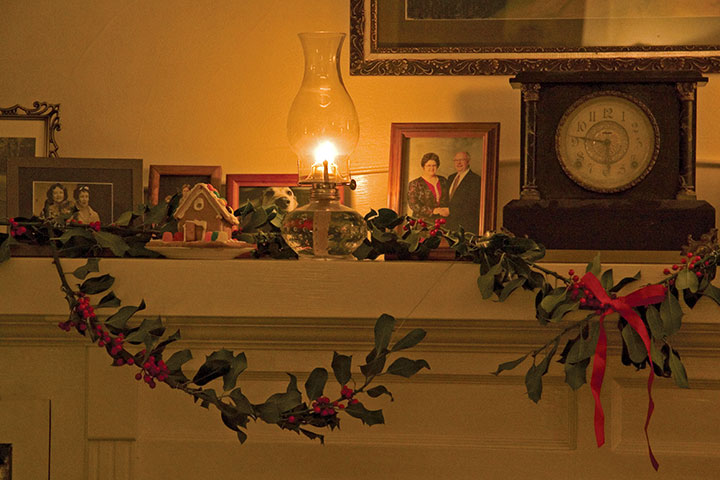
December 10th, 2009
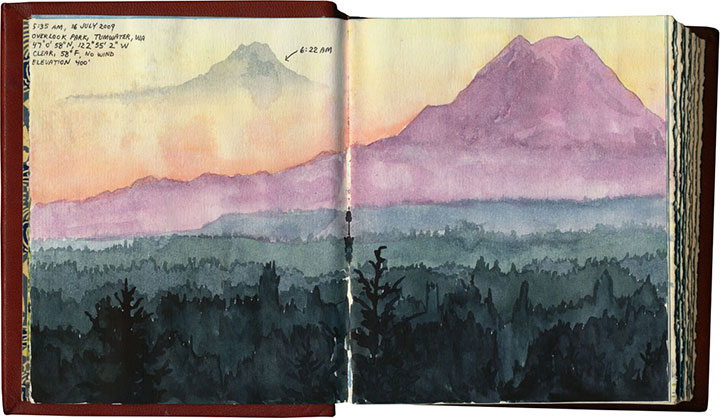
After nearly a year, image-gathering for my Mt. Rainier artist book is finally coming to an end, and I’m starting to make the final illustrations. I have a huge stack of sketches, scribbles and recorded data, and thousands upon thousands of photos to sift through. This month and next are scheduled for the all-important (and terrifying) process of Figuring Out How the Heck to Make It Work—physical mock-ups, final compositions, text-writing, etc. But before I could move on with a clear conscience, I had one last far-away location to cross off my research list: Portland. And for some reason, the stars just weren’t aligning for me.

My first attempt this summer was also my first-ever trip to the city, so I had to location-scout with a blank mental map—and when I finally found what I was looking for, it was too hazy to see anything anyway (hence the dotted line where Rainier should be). Since Portland is 140 miles away, I couldn’t just try again any old time I pleased. As the months went by, I became increasingly frustrated—the location I visited over the summer (Larch Mountain) is inaccessible in the winter, and although I had another spot in mind, my schedule and the weather (which was way harder to pin down than an open travel day!) just couldn’t find anything in common; the last few months have been typically Northwestern, with plenty of rain, fog and drear for a volcano to hide behind. Finally, last week, it seemed I had my chance. T-town was socked in with pea-soup fog, but since the previous day had started the same way and ended in sunshine, I decided to go for it. As I cleared the Puget lowlands and the fog lifted, I caught crystal-clear glimpses of Rainier to the east as I went, and my confidence rose. I wouldn’t know for sure until I got there, but the sunny weather seemed like it would hold. I made good time to Portland, wound my way up to Council Crest Park, jogged up to the viewpoint and faced north—
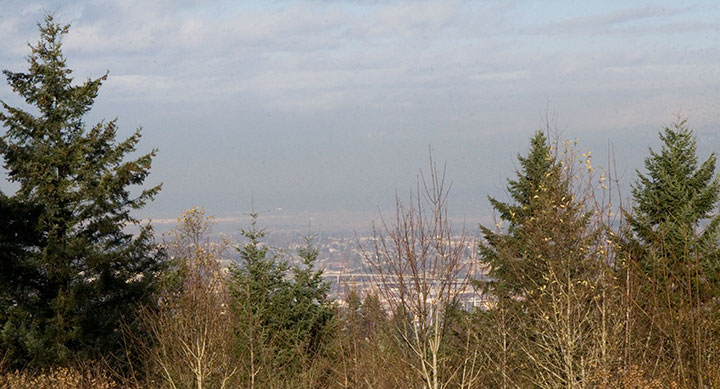
—and saw that Mt. Saint Helens didn’t get the memo. It had its own private weather system blocking Rainier from view.
It was a long drive home that night.
The last few days were torture. The weekend taunted me with sunny mornings and cloudy afternoons (good thing I didn’t take the bait), and the perfect weather went untested Monday and Tuesday while I taught class and kept appointments instead. By Tuesday night, I was sure I’d missed my last chance, and resigned myself to leaving Portland out of the book. But yesterday dawned cold and flawlessly clear, and I was astonished to find my calendar empty. I left the Tailor an incoherent voicemail at work (“I’m going right now! I’ll be back tonight!”) and jumped in the car. Exactly two hours and twenty-three minutes later, this is what I saw:
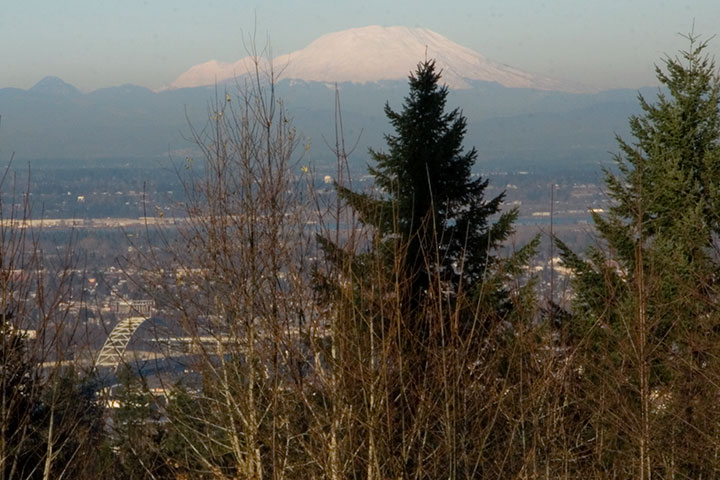
That’s St. Helens in front, with Rainier just peeking around her left shoulder.
And here’s the illustration that resulted from all this work:
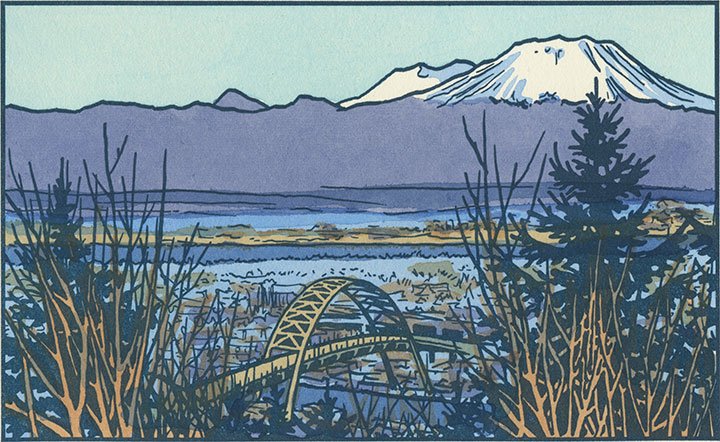
And in case I had any doubts about one image being worth all this trouble, Portland offered me a little bonus—a compositional jewel that I could never have dreamed up on my own:

The City of Roses was still, impossibly, in bloom.









![Chandler O'Leary [logo]](https://chandleroleary.com/wp-content/themes/chandleroleary/images/logo.png)
























































